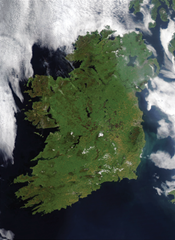An all-island economy update
 agendaNi examines the current state of the all-island economy.
agendaNi examines the current state of the all-island economy.
The all-island economy was described by former Irish Foreign Affairs Minister Dermot Ahern in 2008 as “a sensible and practical co-operation to improve shared social and economic conditions, and to create an innovative and prosperous Ireland.”
The Republic remains Northern Ireland’s second most important trading partner after Great Britain. Great Britain and Northern Ireland is Ireland’s main trading partner. However, competition between Northern Ireland and the Republic for foreign direct investment is expected to increase if Northern Ireland is granted corporation tax-varying powers.
At the height of the boom, the island economy was creating over 80,000 net jobs per annum. It has lost 340,000 net jobs to date and is expected to lose a total of 375-400,000 jobs.
Cross-border trade
Total cross-border trade in manufactured goods increased from £1,345.7 million in 1995 to £2,378.7 million in 2009, with a peak of £2,665.2 million in 2008, at the height of the boom (according to InterTradeIreland figures).
The Republic’s industrial structure is dominated by four sectors: food and beverages; printing, publishing and reproduction of recorded media; chemicals; and electrical and optical equipment. These four sectors account for 63 per cent of manufacturing output. In contrast, Northern Ireland has just one dominant sector, food and beverages, accounting for 25 per cent.
A February 2011 research report by InterTradeIreland exploring the factors affecting cross-border trade found that north-to-south trade was less than expected in rubber and plastics, machinery and transport equipment. South-to-north trade was most active in food and beverages, fuels, rubber and plastics and furniture.
The differences between North and South are reliant on “many relevant factors” such as the need for freshness of product, the value-to-weight ratio, the degree to which the different sectors produce final or intermediate goods and the degree to which sectors are dominated by multi- nationals.
The report adds: “It is not surprising that trade for food, beverages and tobacco and non-metallic minerals such as cement and bricks is at about the appropriate level.”
This is due to food, beverage and tobacco tastes being very similar in both parts of the island, foods being sourced locally for freshness reasons and the value to weight ratio of cement and bricks means that they are not traded over longer distances, but are sourced locally.
Exports
The value of Republic of Ireland goods sold abroad in 2010 was €161 billion. The Irish Exporters Association forecasted a 7 per cent growth in exports for 2011 to €172.6 billion as economies in the Republic’s main markets grow. The strong performance in exports made a positive contribution to state revenues and higher than expected tax revenues from exporting companies enabled the tax revenue target for 2010 to be exceeded. The exports were manufactured goods and tradable services.
April’s merchandise trade figures showed that exports were valued at €7.79 billion, up 6 per cent on the same month last year. Irish Enterprise Minister Richard Bruton said “an export-led recovery [to Brazil, Russia and India] is becoming a real possibility.”
However, in Northern Ireland total sales decreased by 2.9 per cent in 2009-2010 and exports decreased by 11.8 per cent. The 2010 Northern Ireland Manufacturing Sales and Exports Survey showed that sales to the Republic decreased by 9.7 per cent, sales to the EU dropped by 3 per cent, while sales to Great Britain grew by 6.5 per cent in real terms. Great Britain remains the most significant market for Northern Ireland’s manufacturing businesses accounting for £7 billion of total sales.
Freight
Ninety-eight per cent of the merchandise trade in the Republic is carried on the road network, while this rate has grown to 100 per cent in Northern Ireland since 2003 when rail freight ended.
InterTradeIreland’s 2008 ‘Freight Transport Report for the island of Ireland’ made a number of recommendations.
For example, the report recommended better port connectivity to the road network particularly at Belfast’s York Street. A consultation on this is underway and decision on the preferred option is not expected until summer 2012.
The report also called for congestion in major cities to be dealt with and the Dublin Port Tunnel is one example of how that has been achieved. It also advocates the go-ahead of the Leinster outer-orbital route (Drogheda-Navan-Naas) which is not included in the Republic’s Transport 21 Strategy. However, most road projects have been suspended due to lack of funds. The 253km Dublin to Cork motorway was completed before the EU- IMF bail-out but there were no funds left to build service areas along the route for long-distance lorry drivers.
Energy
The energy sector sees significant co- operation between governments north and south through commitments made in the Republic’s Renewable Energy Action Plan (which has a target of 16 per cent renewable in overall energy consumption by 2020) and the Northern Ireland Strategic Energy Framework, which sets a target of 40 per cent of electricity from renewables by 2020.
The Single Electricity Market came into effect in November 2007 and combined the electricity markets in both jurisdictions.
Work is ongoing on the common arrangements for gas which requires parallel primary legislation in Northern Ireland and the Republic to provide for a simpler, more efficient cross border wholesale gas transmission system by October 2012.
In addition, EirGrid is currently consulting on plans for the second North/South interconnector which could facilitate cross-border sharing of electricity and reduce Ireland’s dependency on imported fossil fuels.






